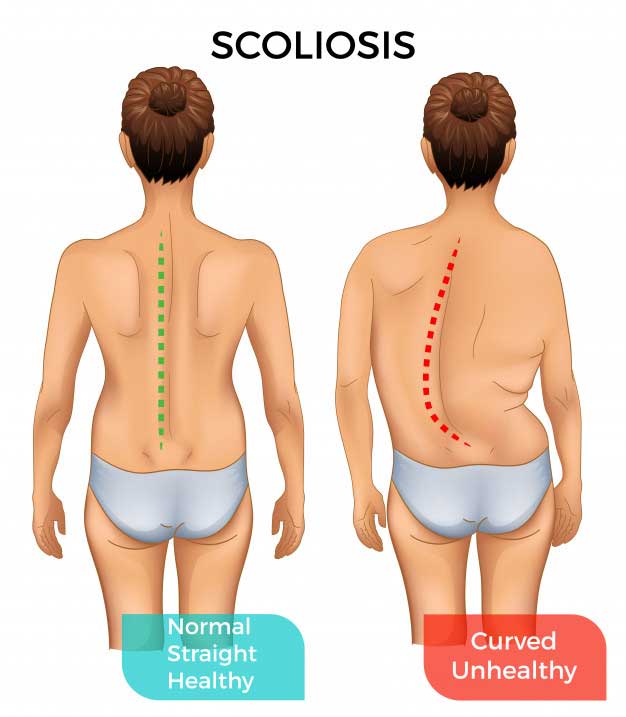The curvature or deviation of the vertebral column is interpreted as scoliosis
What is scoliosis?
This complication is a lateral deviation of the vertebral column, a painless bending of the spine, which sometimes has a progressive state and causes changes in the chest and back. This abnormality can involve the thoracic (middle) or lumbar (lower) vertebrae of the spine.
And it has the highest prevalence in teenagers and is more common in girls than boys.
In the early stages, there are no obvious symptoms, and scoliosis is discovered by a doctor or school health officer during routine examinations.
👈Advanced steps:
⭕️Visible curvature of the upper body. spine to
⭕️The shape of an S or a bow comes out.
⭕️ Shoulders become uneven and rounded.
⭕️Chest depression
⭕️Back wave movement
⭕️Pulling one side of the pelvis forward
⭕️back pain
In this condition, one shoulder can be higher or lower than the other shoulder. Also, the scapula may protrude backwards. In this disease, the pelvis is out of parallel and one side of the pelvis is higher than the other side. In fact, the body is inclined to one side.
Scoliosis has a gradual process. This deviation usually occurs just before or during the maturation of the attention mode. When a growth spurt has been created in a person. Scoliosis is more common in women than men. In few cases, scoliosis is diagnosed in infancy and therefore treatment starts earlier.
Types of scoliosis
The classification of spinal deviation based on congenital or acquired is as follows.
1- Congenital
At birth, a person has a vertebral abnormality and his spine has a lateral deviation. In congenital scoliosis, the curvature of the spine occurs due to the improper shape of the vertebrae.
2- Acquired
It refers to the types of scoliosis that a person suffers from during her life under the influence of various factors.
Complications of scoliosis
* the pain
* Dysfunction of the cardio-pulmonary system
* Neurological disorders
* Walking disorder
* Decreased mobility of the spine
Signs and symptoms
* At the beginning of the disease, scoliosis is often painless and can be difficult to diagnose.
* Not placing the shoulders or both sides of the pelvis on the same level, for example, one shoulder is higher than the other.
* Having a hump on one side of the spine in the back
* Weakness of the muscles on one side of the vertebral column, which shows itself in the examination as atrophy of the muscles on one side of the vertebral column.
* Chronic back pain
* drooping shoulders
* Sleeping on one side when lying on the back due to rotation of the spine to one side
.
diagnosis
* Check the history mentioned above
* Examination of the spine by a doctor to check its curvature, whether there is lumbar scoliosis or scoliosis in the chest area.
* During the examination, the doctor will ask you to bend forward (like bowing) and in this position he will check the deviation of your spine to one side.
⭕️Prevalence
🔸Scoliosis usually appears before the age of 14 and its prevalence rate is 1.9%. The highest prevalence of this disease is during adolescence and its prevalence is five times higher in girls than in boys.
⭕️types/causes
🔻Postural (functional) scoliosis
This type of scoliosis in school children is caused by repeated wrong postures. Weakness of the spine muscles along with prolonged sitting causes more pressure on the vertebrae.
It is difficult for the child to be in the right positions due to muscle weakness, and therefore by leaning on one side, it makes sitting comfortable and bearable.
When the child puts the strap of the bag on the left shoulder, in order not to slip the strap of the bag, he keeps his shoulder higher, and in this case, the tendency of the spine to curve to the left increases.
Children who constantly do unbalanced work or recreational activities are prone to disrupting the balance of muscle forces, which can cause the spine to curve to the sides, and when different positions of the spine habitually curve to one side; This issue is significant and it should be prevented and corrected to prevent premature scoliosis.
🔻structural scoliosis
In this type of scoliosis, the spine loses its flexibility, and no matter what position the patient takes, the lateral deviation of the spine does not disappear. This type of scoliosis is often caused by the deformation of the vertebra and bone problems such as osteoporosis.
The only way to treat this type of scoliosis is surgery.
❇️70-90% of scoliosis is correctable and in this type, most curves are completely corrected 18-24 months after diagnosis..
Brace treatment
Brace is the most widely used treatment or prevention agent for the development of spinal deviation or scoliosis in order to reduce the possibility of aggravation of deformity and deviation. In order to get the best results, standard braces should be used, which are done in the rehabilitation centers of this type of patients by preparing a 3D scan and measuring the patient’s condition from different angles, and the obtained numbers are entered into the software until after analysis. Analyzing the body condition of the mentioned patient, the appropriate plastic brace should be formed.


